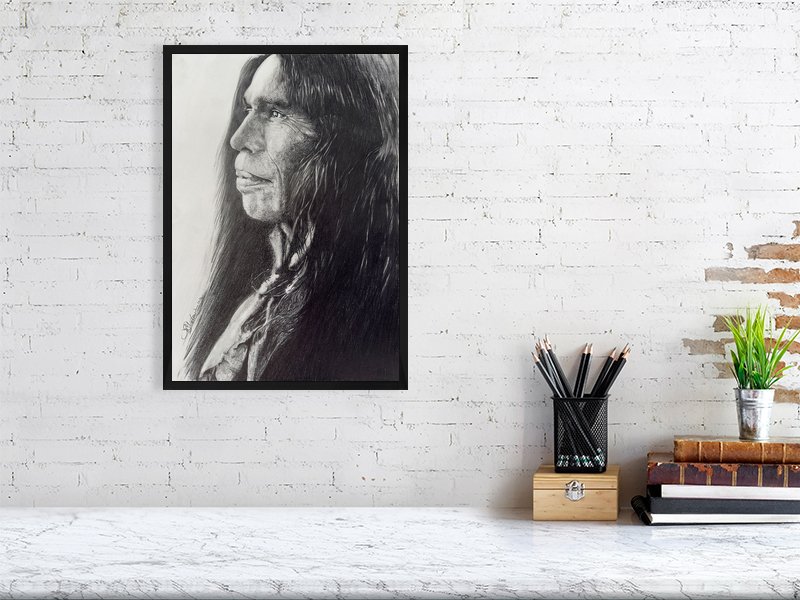A Coast Pomo (Framed Prints)
A Coast Pomo
A high-quality fine art giclee print on archival quality paper made from a high-resolution digital image of the original artwork, available in three sizes - A4, A3 and A2.
Black FSC®-certified wood frames, complete with high quality glass windows, ready to be hung on the customer’s wall.
Original digital image of artwork – 16.1mb, 5459 x 7883 pixels, 300dpi, 24 bit depth.
Original graphite pencil drawing created on Daler Rowney Fine Grain paper, 200gsm, size A3 (42cm x 29.7cm), using Faber Castell 9000 series graphite pencils, Putty rubber and Tombow precision erasers. Time taken: Circa 30-40 hours (June 2024)
Source Material: Original photograph by Edward S. Curtis, titled “A Mixed-Blood Coast Pomo”, c. 1924.
(The original artwork is not for sale.)
A Coast Pomo
A high-quality fine art giclee print on archival quality paper made from a high-resolution digital image of the original artwork, available in three sizes - A4, A3 and A2.
Black FSC®-certified wood frames, complete with high quality glass windows, ready to be hung on the customer’s wall.
Original digital image of artwork – 16.1mb, 5459 x 7883 pixels, 300dpi, 24 bit depth.
Original graphite pencil drawing created on Daler Rowney Fine Grain paper, 200gsm, size A3 (42cm x 29.7cm), using Faber Castell 9000 series graphite pencils, Putty rubber and Tombow precision erasers. Time taken: Circa 30-40 hours (June 2024)
Source Material: Original photograph by Edward S. Curtis, titled “A Mixed-Blood Coast Pomo”, c. 1924.
(The original artwork is not for sale.)
A Coast Pomo
A high-quality fine art giclee print on archival quality paper made from a high-resolution digital image of the original artwork, available in three sizes - A4, A3 and A2.
Black FSC®-certified wood frames, complete with high quality glass windows, ready to be hung on the customer’s wall.
Original digital image of artwork – 16.1mb, 5459 x 7883 pixels, 300dpi, 24 bit depth.
Original graphite pencil drawing created on Daler Rowney Fine Grain paper, 200gsm, size A3 (42cm x 29.7cm), using Faber Castell 9000 series graphite pencils, Putty rubber and Tombow precision erasers. Time taken: Circa 30-40 hours (June 2024)
Source Material: Original photograph by Edward S. Curtis, titled “A Mixed-Blood Coast Pomo”, c. 1924.
(The original artwork is not for sale.)
The Pomo are a Native American people of California. Historical Pomo territory in Northern California was large, bordered by the Pacific Coast to the west, extending inland to Clear Lake, mainly between Cleone and Duncans Point. One small group, the Tceefoka (Northeastern Pomo), lived in the vicinity of presentday Stonyford, Colusa County, where they were separated from the majority of Pomo lands by Yuki and Wintuan speakers.
The name Pomo derives from a conflation of the Pomo words [pʰoːmoː] and [pʰoʔmaʔ].[1] It originally meant "those who live at red earth hole" and was once the name of a village in southern Potter Valley, near the present-day community of Pomo, Mendocino County. The word may also have referred to the local deposits of red magnesite (mined and utilized for making
red beads) or to the reddish, earthen clay soil of the area, rich in hematite (also mined for use). In the Northern Pomo dialect, -pomo or -poma was used as a suffix after the names of places, to mean a subgroup of people of the place. By 1877, the meaning of the word Pomo had been broadened, at least in the English language, to refer to not only the Pomo language but the entire group of people speaking it, as well—the people known as Pomo, today.
Retrieved from https://en.wikipedia.org/w/index.php?title=Pomo&oldid=1241514785
Gold, Greed & Genocide: The Pomo & The Paiute (http://www.1849.org/ggg/pomo.html)










